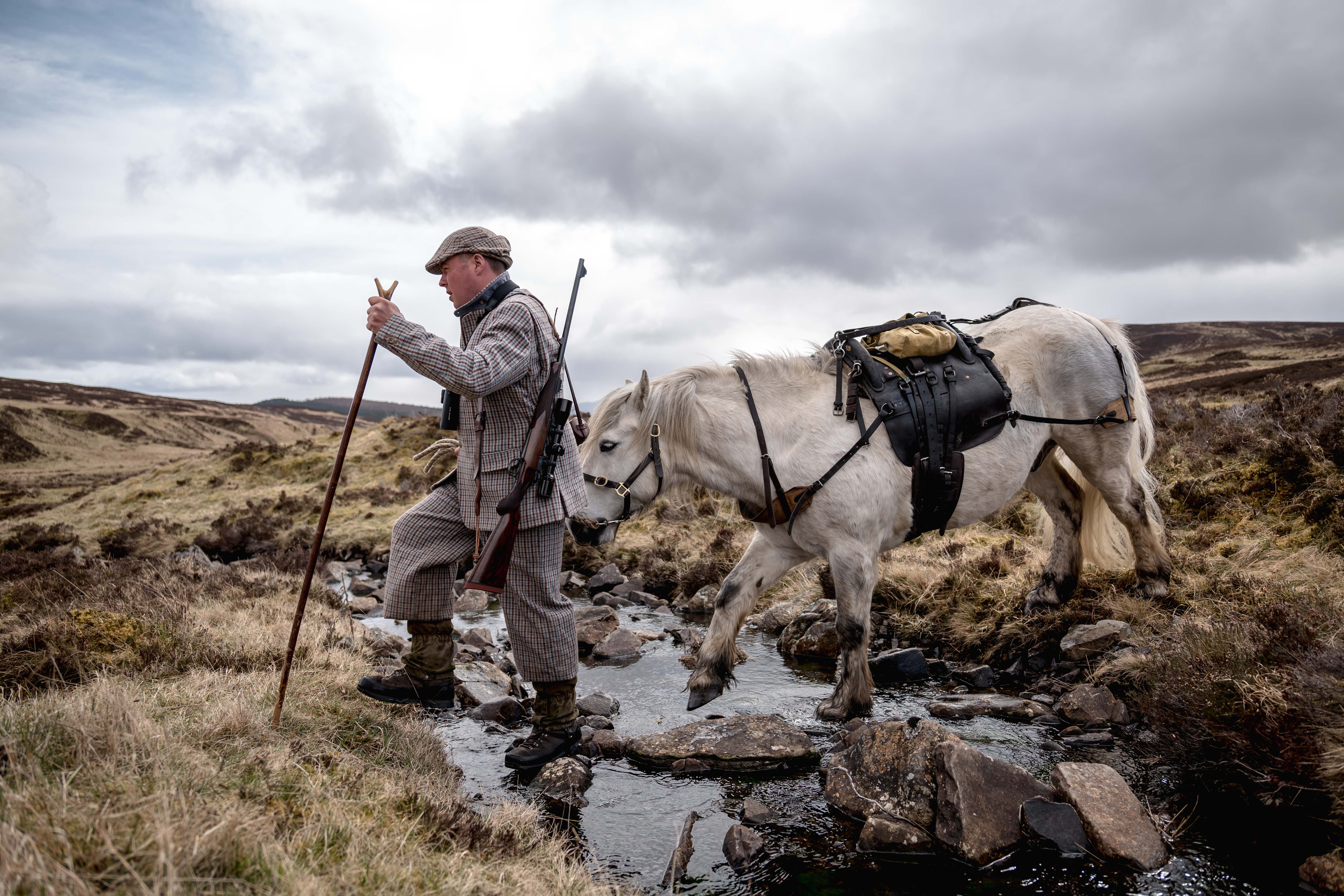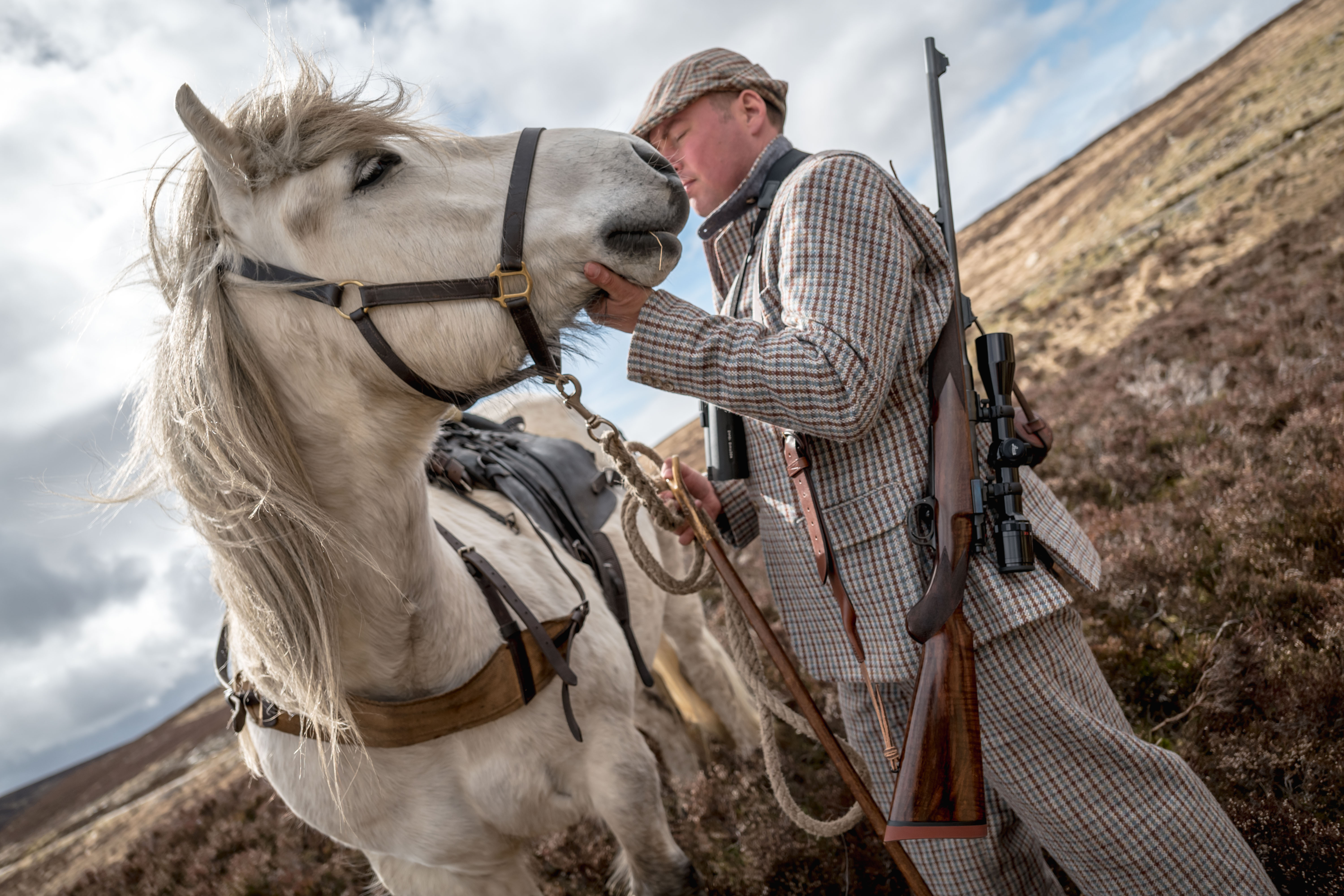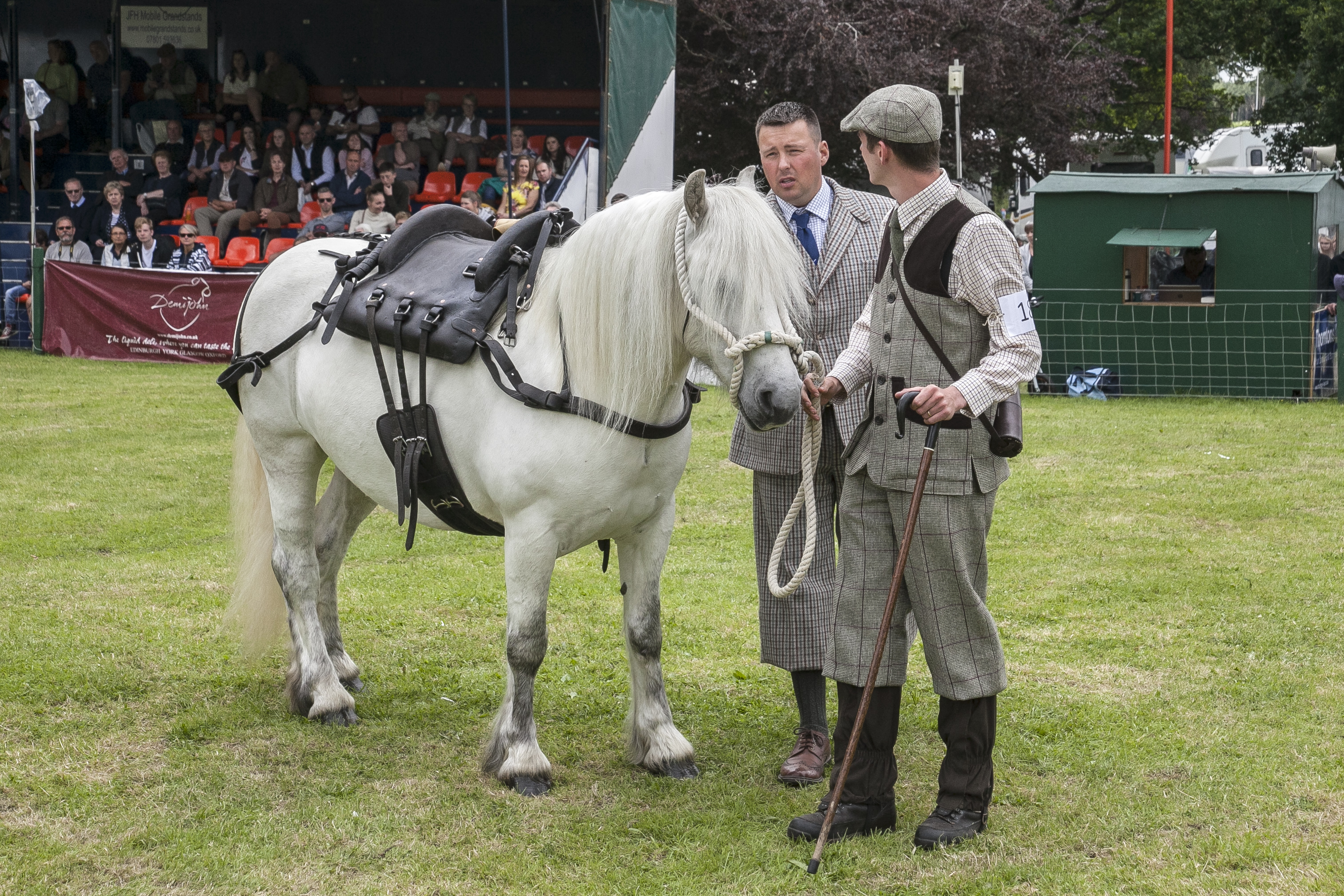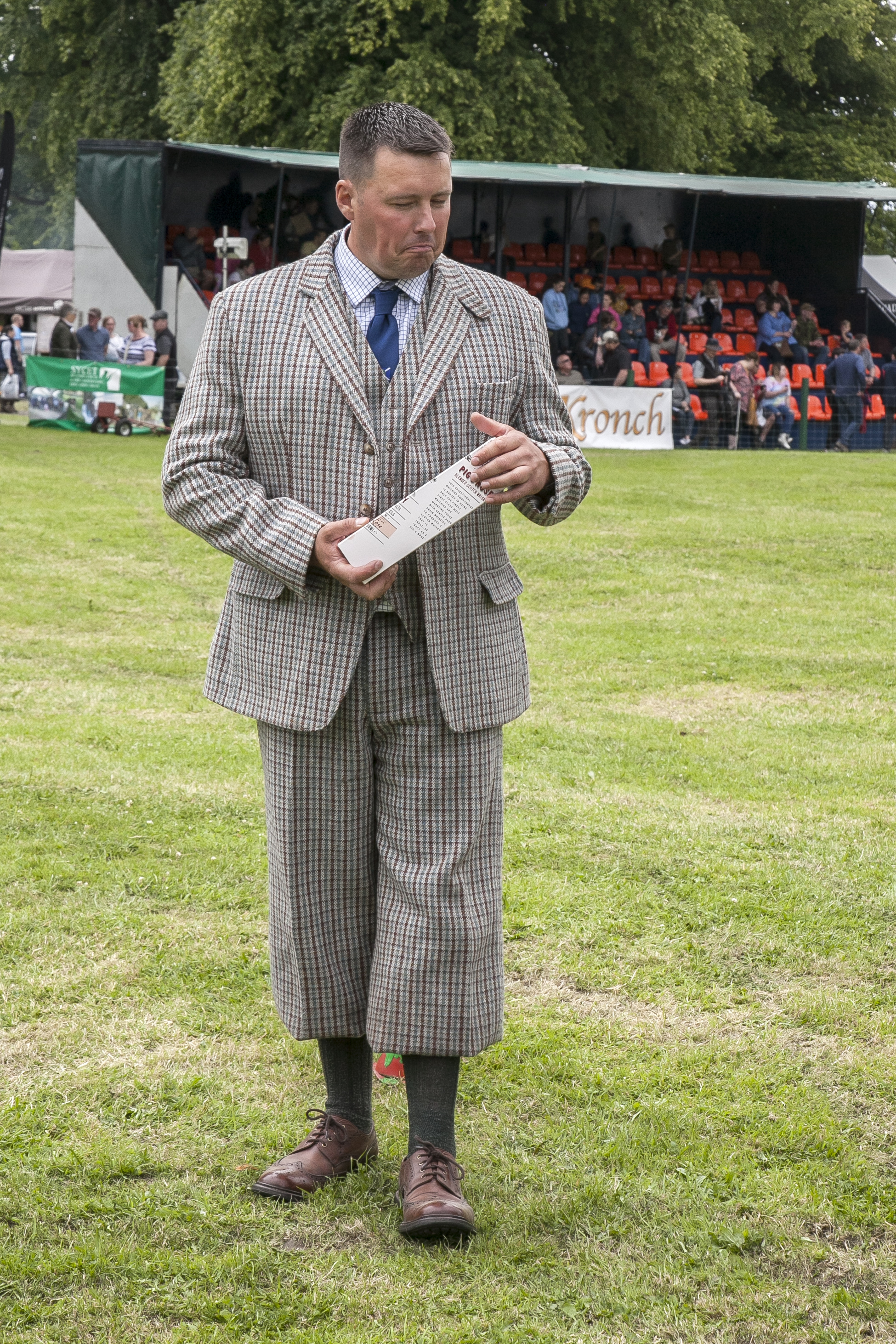
Richard Fraser – Scotland’s king of the hill pony
Richard Fraser has been working hill ponies since starting out as a 16-year old trainee on Perthshire’s Atholl Estates.
Now 39 and head stalker, Richard Fraser knows this renowned native breed of the Scottish Highlands better than most, so the only surprise when he was asked to judge this year’s prestigious show at the Scottish Game Fair was that he hadn’t been asked before.
Having worked with hill ponies for all of his stalking life, Richard found it far from easy to choose a winner when the finest in the country gathered in Scone at the Scottish Game Fair for the Fred Taylor Memorial Trophy for Working Hill Ponies.
Over many centuries, the Highland pony has become adaptable to the most severe conditions. Strong, well-balanced and compact, the working breed is renowned for substance, strength and stamina – bred for carrying a stag home at the end of a successful day’s stalking out on the hills.
Traditionally bred for and used by stalkers in the Scottish Highlands to carry home deer, working hill ponies are not used in the same numbers as they used to be.
Nevertheless, Richard still believes the more modern method of extracting deer on a quad bike is no substitute for the job ponies can do or the bond that they form with their owners. The Fred Taylor Memorial Trophy is an ideal way to celebrate and promote their traditional value.

Richard Taylor out in the Atholl Estates
Richard, who owns 10 working hill ponies along with his wife on the Atholl Estates, explained: ‘We’re not shooting the same number of stags in Scotland to justify owning a pony all year round to take deer off a hill – it’s just the way things have changed.
‘Some estates are more into their grouse as well, so they’re not really looking for ponies as much as they used to. But the more traditional estates, like Atholl, are still using ponies. It’s the more romantic side of deer stalking and I’m sure the tradition will continue because there is nothing better at extracting deer from the field.
‘On steep, rocky ground that machinery can’t access, ponies are the only way to do it. Guests like the tradition of going out stalking with the Highland pony behind them. It’s more enjoyable than stalking with a quadbike. We need to remember that and the Fred Taylor Memorial Trophy is a good way to do so.’
Richard and his wife breed their own, some for showing, some for working on the hill. Like training a working dog, patience and perseverance is required to establish a working hill pony that is up to the job. It can take three or four years for a pony to be confident and strong enough to do what is required on a full day deer stalking.
He continued: ‘It can take a long time, but it really depends on the pony. If we had a working mare and put her in to foal, the foal would be out the next season, following at foot. They need to get used to being on the hill and where to put its feet on soft ground. Once they are surefooted, I would progress by shooting a stag and introducing the young foal to it. I’ve seen them stand there nibbling the antlers or licking the blood. It’s just a case of getting them used to the smells and the dead animal in front of them.

Richard Taylor with his four-legged friend
‘You progress from there. At three years old you start getting a deer saddle on them and get them used to the weight. They’re a lot of heavier than a riding saddle and have all the straps hanging off them. I like to put a deer skin over the fence near their water trough, so they get used to that smell.
‘Then you might put a red calf on its back, see how it gets on and take it from there. You’d move to a hind or a young stag with the antlers cut off, just to get them used to a heavier weight. I usually try to do a hind season with them before moving on to do the stags. Obviously stags are heavier and there are antlers to contend with too.
‘It’s funny how the pony temperaments can be so different. Some of them just don’t take to it at all, no matter what you do. They all have their own unique personalities. I’m used to being out six days a week for 12 weeks of stalking, so you do bond with your pony because you’re out with it every day.
‘You have to stick at it. It’s like training a dog. You have to throw a dog a dummy and teach them to retrieve. It’s the same with a pony and a stag. It doesn’t just happen. You’ve got to keep up the training, little but often. You need to do at least 20 minutes a day doing bits and bobs with the pony and getting them used to you. It’s the whole process. It’s not just a case of throwing a beast on the back and hoping for the best and away you go. Most of them will take to it relatively easily. But you do get complete nutters that will not take to it. I’ve persevered with one before eventually giving away to a trekking centre. It’s all about the temperament.
‘I’ve had good fun with the ponies over the years and it’s great to see that interest in the breed is still strong. You could write a book about them. You wouldn’t be able to write a book about a quad bike.’
Set up in memory of Fred Taylor, head stalker at Invermark Estate in Glenesk for 30 years who died in 2012, the competition organised by the Game and Wildlife Conservation Trust and the Association of Deer Management Groups, is a fabulous display of the finest working hill ponies in the country and continues to draw an impressive entry list.

Richard Taylor judging the working hill pony class
Richard said: ‘You don’t see classes as big anywhere else. Even at the Highland Show you might only get four entrants for the working pony class. But I had 12 to choose between.’
Along with ghillies in their estate tweeds, ponies are tacked up with either deer saddles or game panniers and parade themselves in the arena before being inspected closely by the judge. When the quality and number of entries is so high, the judge needs to have an expert eye for details.
Richard, who has entered the competition himself every year since it was first held in 2013 but has actually never managed to win, said: ‘It is my job to identify the smallest of faults. This breed is designed for working in the forests and on the hill. They’ve got good strength and they’re stocky, which means they are ideal for carrying. That’s what I’m looking for.
‘I’ve personally put a 20-stone stag on the back of a pony and walked eight miles home. You need a sturdy pony that’s going to manage to do that.
‘When trying to identify a winner of the Fred Taylor Memorial Trophy, I was looking for a saddle and a pony that I would take to the hill myself for a day’s stalking.
‘So, they needed to have all the correct straps, all the correct buckles, spare buckles in their piece bag … things like that.
‘I was looking for a strong-looking pony with excellent confirmation that could carry a mature stag for a long time. Good legs, good bones and big feet for walking on softer ground. The whole set-up. In the past, I’ve seen entrants who don’t have their saddles or game panniers fastened properly, but most entrants know what they’re doing.’

Richard Taylor judging at Scone
There is huge interest in the class, due in part to the sponsorship of London gunmaker John Rigby & Co. Win the same class at the Highland Show and you would probably earn less than £100 in cash – not quite the same as winning a rifle worth £12,000. Richard noted: ‘That’s why there’s such a good turnout.’
This year’s winning ghillie Rebecca Cantwell and her Highland pony Balmoral Harmony from The Queen’s Balmoral Estate in Royal Deeside certainly did. She receives one of Rigby’s Highland Stalker rifles in .275 Rigby, specially engraved with a silver shield inlaid into the rifle’s stock.
Although a relatively new pairing, Rebecca – who won bronze the only other time she entered three years earlier – worked with eight-year old Balmoral Harmony for ten months before the Scottish Game Fair and the mare had completed three seasons on the hill.
Richard said: ‘The pony and her ghillie had it all. I had a notepad and I didn’t mark down one fault on him. The duo that came second, Highland pony Lexi from Meggernie estate with handler Steven MacDonald, had just one minor fault.
‘Overall, the standard of the entries was really impressive. It was a great privilege to judge. I’ve always wanted to do it, so when asked I was more than delighted. It was good fun, but certainly not easy because the standard was so high and the competition really was fierce.’
TAGS

